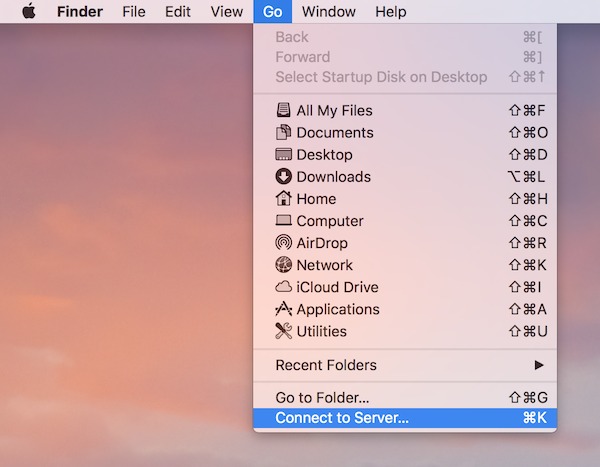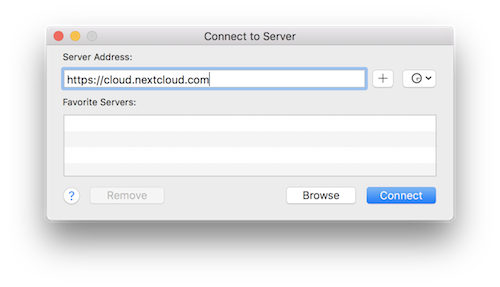Accessing Nextcloud files using WebDAV
Nextcloud fully supports the WebDAV protocol, and you can connect and synchronize with your Nextcloud files over WebDAV. In this chapter you will learn how to connect Linux, macOS, Windows, and mobile devices to your Nextcloud server via WebDAV. Before we get into configuring WebDAV, let’s take a quick look at the recommended way of connecting client devices to your Nextcloud servers.
Note
In the following examples, you should replace example.com/nextcloud with the URL of your Nextcloud server (omit the directory part if the installation is in the root of your domain), and “USERNAME” with the username of the connecting user.
See the WebDAV URL (bottom left in settings) on your Nextcloud.
Note
In the following examples, you must use an app-password for login, which you can generate in your security settings.
Nextcloud Desktop and mobile clients
The recommended way to synchronize a desktop PC with a Nextcloud server is by using Nextcloud/ownCloud sync clients. You can configure the client to save files in any local directory and you can choose which directories on the Nextcloud server to sync with. The client displays the current connection status and logs all activity, so you always know which remote files have been downloaded to your PC and you can verify that files created and updated on your local PC are properly synchronized with the server.
The recommended way to synchronize Nextcloud server with Android and Apple iOS devices is by using the mobile apps.
To connect your mobile app to a Nextcloud server use the base URL and folder only:
example.com/nextcloud
In addition to the mobile apps provided by Nextcloud or ownCloud, you can use other apps to connect to Nextcloud from your mobile device using WebDAV. WebDAV Navigator is a good (proprietary) app for Android devices and iPhones. The URL to use on these is:
example.com/nextcloud/remote.php/dav/files/USERNAME/
WebDAV configuration
If you prefer, you may also connect your desktop PC to your Nextcloud server by using the WebDAV protocol rather than using a special client application. Web Distributed Authoring and Versioning (WebDAV) is a Hypertext Transfer Protocol (HTTP) extension that makes it easy to create, read, and edit files on Web servers. With WebDAV you can access your Nextcloud shares on Linux, macOS and Windows in the same way as any remote network share, and stay synchronized.
Accessing files using Linux
You can access files in Linux operating systems using the following methods.
Nautilus file manager
When you configure your Nextcloud account in the GNOME Control Center, your files will automatically be mounted by Nautilus as a WebDAV share, unless you deselect file access.
You can also mount your Nextcloud files manually. Use the davs://
protocol to connect the Nautilus file manager to your Nextcloud
share:
davs://example.com/nextcloud/remote.php/dav/files/USERNAME/
Note
If your server connection is not HTTPS-secured, use dav:// instead
of davs://:
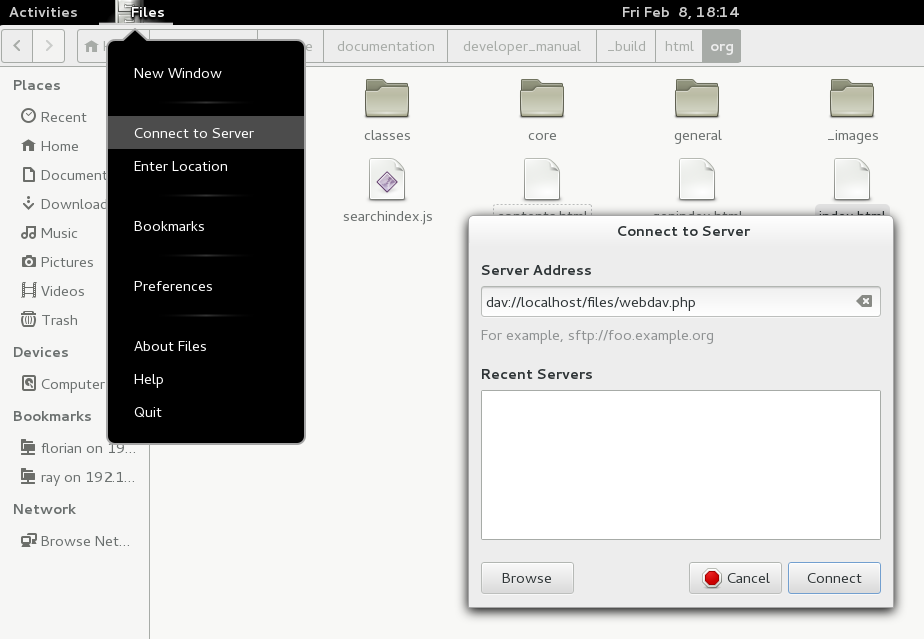
Note
The same method works for other file managers that use GVfs, such as MATE’s Caja and Cinnamon’s Nepomuk.
Accessing files with KDE and Dolphin file manager
To access your Nextcloud files using the Dolphin file manager in KDE, use
the webdav:// protocol:
webdav://example.com/nextcloud/remote.php/dav/files/USERNAME/
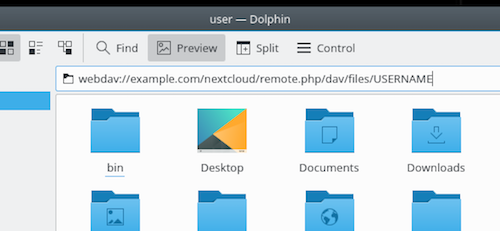
You can create a permanent link to your Nextcloud server:
Open Dolphin and click “Network” in the left hand “Places” column.
Click on the icon labeled Add a Network Folder. The resulting dialog should appear with WebDAV already selected.
If WebDAV is not selected, select it.
Click Next.
Enter the following settings:
Name: The name you want to see in the Places bookmark, for example Nextcloud.
User: The Nextcloud username you used to log in, for example admin.
Server: The Nextcloud domain name, for example example.com (without http:// before or directories afterwards).
Folder – Enter the path
nextcloud/remote.php/dav/files/USERNAME/.
(Optional) Check the “Create icon” checkbox for a bookmark to appear in the Places column.
(Optional) Provide any special settings or an SSL certificate in the “Port & Encrypted” checkbox.
Creating WebDAV mounts on the Linux command line
You can create WebDAV mounts from the Linux command line. This is useful if you prefer to access Nextcloud the same way as any other remote filesystem mount. The following example shows how to create a personal mount and have it mounted automatically every time you log in to your Linux computer.
Install the
davfs2WebDAV filesystem driver, which allows you to mount WebDAV shares just like any other remote filesystem. Use this command to install it on Debian/Ubuntu:apt-get install davfs2
Use this command to install it on CentOS, Fedora, and openSUSE:
yum install davfs2
Add yourself to the
davfs2group:usermod -aG davfs2 <username>
Then create a
nextclouddirectory in your home directory for the mountpoint, and.davfs2/for your personal configuration file:mkdir ~/nextcloud mkdir ~/.davfs2
Copy
/etc/davfs2/secretsto~/.davfs2:cp /etc/davfs2/secrets ~/.davfs2/secrets
Set yourself as the owner and make the permissions read-write owner only:
chown <linux_username>:<linux_username> ~/.davfs2/secrets chmod 600 ~/.davfs2/secrets
Add your Nextcloud login credentials to the end of the
secretsfile, using your Nextcloud server URL and your Nextcloud username and password:https://example.com/nextcloud/remote.php/dav/files/USERNAME/ <username> <password> or $PathToMountPoint $USERNAME $PASSWORD for example /home/user/nextcloud john 1234
Add the mount information to
/etc/fstab:https://example.com/nextcloud/remote.php/dav/files/USERNAME/ /home/<linux_username>/nextcloud davfs user,rw,auto 0 0
Then test that it mounts and authenticates by running the following command. If you set it up correctly you won’t need root permissions:
mount ~/nextcloud
You should also be able to unmount it:
umount ~/nextcloud
Now every time you login to your Linux system your Nextcloud share should
automatically mount via WebDAV in your ~/nextcloud directory. If you prefer
to mount it manually, change auto to noauto in /etc/fstab.
Known issues
Problem
Resource temporarily unavailable
Solution
If you experience trouble when you create a file in the directory,
edit /etc/davfs2/davfs2.conf and add:
use_locks 0
Problem
Certificate warnings
Solution
If you use a self-signed certificate, you will get a warning. To
change this, you need to configure davfs2 to recognize your certificate.
Copy mycertificate.pem to /etc/davfs2/certs/. Then edit
/etc/davfs2/davfs2.conf and uncomment the line servercert. Now add the
path of your certificate as in this example:
servercert /etc/davfs2/certs/mycertificate.pem
Accessing files using macOS
Note
The macOS Finder suffers from a series of implementation problems and should only be used if the Nextcloud server runs on Apache and mod_php, or Nginx 1.3.8+. Alternative macOS-compatible clients capable of accessing WebDAV shares include open source apps like Cyberduck (see instructions here) and Filezilla. Commercial clients include Mountain Duck, Forklift, Transmit, and Commander One.
To access files through the macOS Finder:
From the Finder’s top menu bar, choose Go > Connect to Server…:
When the Connect to Server… window opens, enter your Nextcloud server’s WebDAV address in the Server Address: field, i.e.:
https://cloud.YOURDOMAIN.com/remote.php/dav/files/USERNAME/
Click Connect. Your WebDAV server should appear on the Desktop as a shared disk drive.
Accessing files using Microsoft Windows
If you use the native Windows implementation of WebDAV, you can map Nextcloud to a new drive using Windows Explorer. Mapping to a drive enables you to browse files stored on a Nextcloud server the way you would files stored in a mapped network drive.
Using this feature requires network connectivity. If you want to store your files offline, use the Desktop Client to sync all files on your Nextcloud to one or more directories of your local hard drive.
Note
Windows 10 now defaults to allow Basic Authentication if HTTPS is
enabled prior to mapping your drive. On older versions of Windows,
you must permit the use of Basic Authentication in the Windows
Registry: launch regedit and navigate to
HKEY_LOCAL_MACHINE\SYSTEM\CurrentControlSet\Services\WebClient\Parameters.
Create or edit the DWORD value BasicAuthLevel (Windows Vista, 7 and 8) or
UseBasicAuth (Windows XP and Windows Server 2003) and set its value data
to 1 for SSL connections. Value 0 means that Basic Authentication is disabled,
a value of 2 allows both SSL and non-SSL connections (not recommended).
Then exit Registry Editor, and restart the computer.
Mapping drives with the command line
The following example shows how to map a drive using the command line. To map the drive:
Open a command prompt in Windows.
Enter the following line in the command prompt to map to the computer Z drive:
net use Z: https://<drive_path>/remote.php/dav/files/USERNAME/ /user:youruser yourpassword
where <drive_path> is the URL to your Nextcloud server.
For example: net use Z: https://example.com/nextcloud/remote.php/dav/files/USERNAME/
/user:youruser yourpassword
The computer maps the files of your Nextcloud account to the drive letter Z.
Note
Though not recommended, you can also mount the Nextcloud server using HTTP, leaving the connection unencrypted. If you plan to use HTTP connections on devices while in a public place, we strongly recommend using a VPN tunnel to provide the necessary security.
An alternative command syntax is:
net use Z: \\example.com@ssl\nextcloud\remote.php\dav /user:youruser
yourpassword
Mapping drives with Windows Explorer
To map a drive using the Microsoft Windows Explorer:
Open Windows Explorer on your MS Windows computer.
Right-click on Computer entry and select Map network drive… from the drop-down menu.
Choose a local network drive to which you want to map Nextcloud.
Specify the address to your Nextcloud instance, followed by /remote.php/dav/files/USERNAME/.
For example:
https://example.com/nextcloud/remote.php/dav/files/USERNAME/
Note
For SSL protected servers, check Reconnect at sign-in to ensure that the mapping is persistent upon subsequent reboots. If you want to connect to the Nextcloud server as a different user, check Connect using different credentials.
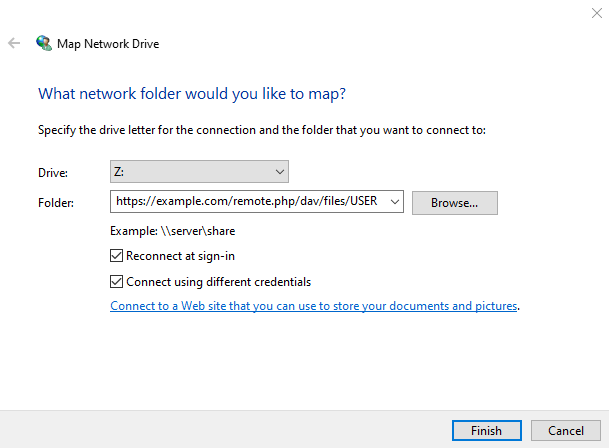
Click the
Finishbutton.
Windows Explorer maps the network drive, making your Nextcloud instance available.
Accessing files using Cyberduck
Cyberduck is an open source FTP and SFTP, WebDAV, OpenStack Swift, and Amazon S3 browser designed for file transfers on macOS and Windows.
Note
This example uses Cyberduck version 4.2.1.
To use Cyberduck:
Specify a server without any leading protocol information. For example:
example.com
Specify the appropriate port. The port you choose depends on whether or not your Nextcloud server supports SSL. Cyberduck requires that you select a different connection type if you plan to use SSL. For example:
80 (for WebDAV)
443 (for WebDAV (HTTPS/SSL))
Use the ‘More Options’ drop-down menu to add the rest of your WebDAV URL into the ‘Path’ field. For example:
remote.php/dav/files/USERNAME/
Now Cyberduck enables file access to the Nextcloud server.
Known problems
Problem
Windows does not connect using HTTPS.
Solution 1
The Windows WebDAV Client might not support Server Name Indication (SNI) on encrypted connections. If you encounter an error mounting an SSL-encrypted Nextcloud instance, contact your provider about assigning a dedicated IP address for your SSL-based server.
Solution 2
The Windows WebDAV Client might not support TLSv1.1 and TLSv1.2 connections. If you have restricted your server config to only provide TLSv1.1 and above the connection to your server might fail. Please refer to the WinHTTP documentation for further information.
Problem
You receive the following error message: Error 0x800700DF: The file size exceeds the limit allowed and cannot be saved.
Solution
Windows limits the maximum size a file transferred from or to a WebDAV share may have. You can increase the value FileSizeLimitInBytes in HKEY_LOCAL_MACHINE\SYSTEM\CurrentControlSet\Services\WebClient\Parameters by clicking on Modify.
To increase the limit to the maximum value of 4GB, select Decimal, enter a value of 4294967295, and reboot Windows or restart the WebClient service.
Problem
Accessing your files from Microsoft Office via WebDAV fails.
Solution
Known problems and their solutions are documented in the KB2123563 article.
Problem
Cannot map Nextcloud as a WebDAV drive in Windows using self-signed certificate.
Solution
Go to the your Nextcloud instance via your favorite Web browser.
Click through until you get to the certificate error in the browser status line.
View the cert, then from the Details tab, select Copy to File.
Save to the desktop with an arbitrary name, for example
myNextcloud.pem.Start, Run, MMC.
File, Add/Remove Snap-In.
Select Certificates, Click Add, My User Account, then Finish, then OK.
Dig down to Trust Root Certification Authorities, Certificates.
Right-Click Certificate, Select All Tasks, Import.
Select the Save Cert from the Desktop.
Select Place all Certificates in the following Store, Click Browse.
Check the Box that says Show Physical Stores, Expand out Trusted Root Certification Authorities, and select Local Computer there, click OK, Complete the Import.
Check the list to make sure it shows up. You will probably need to Refresh before you see it. Exit MMC.
Open Browser, select Tools, Delete Browsing History.
Select all but In Private Filtering Data, complete.
Go to Internet Options, Content Tab, Clear SSL State.
Close browser, then re-open and test.
Problem
You cannot download more than 50 MB or upload large files when the upload takes longer than 30 minutes using Web Client in Windows 7.
Solution
Workarounds are documented in the KB2668751 article.
Accessing files using cURL
Since WebDAV is an extension of HTTP, cURL can be used to script file operations.
Note
Settings → Administration → Sharing → Allow users on this
server to send shares to other servers. If this option is disabled the
option --header "X-Requested-With: XMLHttpRequest" needs to be passed to
cURL.
To create a folder with the current date as name:
$ curl -u user:pass -X MKCOL "https://example.com/nextcloud/remote.php/dav/files/USERNAME/$(date '+%d-%b-%Y')"
To upload a file error.log into that directory:
$ curl -u user:pass -T error.log "https://example.com/nextcloud/remote.php/dav/files/USERNAME/$(date '+%d-%b-%Y')/error.log"
To move a file:
$ curl -u user:pass -X MOVE --header 'Destination: https://example.com/nextcloud/remote.php/dav/files/USERNAME/target.jpg' https://example.com/nextcloud/remote.php/dav/files/USERNAME/source.jpg
To get the properties of files in the root folder:
$ curl -X PROPFIND -H "Depth: 1" -u user:pass https://example.com/nextcloud/remote.php/dav/files/USERNAME/ | xml_pp
<?xml version="1.0" encoding="utf-8"?>
<d:multistatus xmlns:d="DAV:" xmlns:oc="http://nextcloud.org/ns" xmlns:s="http://sabredav.org/ns">
<d:response>
<d:href>/nextcloud/remote.php/dav/files/USERNAME/</d:href>
<d:propstat>
<d:prop>
<d:getlastmodified>Tue, 13 Oct 2015 17:07:45 GMT</d:getlastmodified>
<d:resourcetype>
<d:collection/>
</d:resourcetype>
<d:quota-used-bytes>163</d:quota-used-bytes>
<d:quota-available-bytes>11802275840</d:quota-available-bytes>
<d:getetag>"561d3a6139d05"</d:getetag>
</d:prop>
<d:status>HTTP/1.1 200 OK</d:status>
</d:propstat>
</d:response>
<d:response>
<d:href>/nextcloud/remote.php/dav/files/USERNAME/welcome.txt</d:href>
<d:propstat>
<d:prop>
<d:getlastmodified>Tue, 13 Oct 2015 17:07:35 GMT</d:getlastmodified>
<d:getcontentlength>163</d:getcontentlength>
<d:resourcetype/>
<d:getetag>"47465fae667b2d0fee154f5e17d1f0f1"</d:getetag>
<d:getcontenttype>text/plain</d:getcontenttype>
</d:prop>
<d:status>HTTP/1.1 200 OK</d:status>
</d:propstat>
</d:response>
</d:multistatus>
Accessing files using WinSCP
WinSCP is an open source free SFTP client, FTP client, WebDAV client, S3 client and SCP client for Windows. Its main function is file transfer between a local and a remote computer. Beyond this, WinSCP offers scripting and basic file manager functionality.
You can download the portable version of WinSCP and run it on Linux through Wine.
To run WinSCP on Linux, download wine through your distribution’s package manager, then run it via: wine WinSCP.exe.
To connect to Nextcloud:
Start WinSCP
Press ‘Session’ in the menu
Press the ‘New Session’ menu option
Set the ‘File protocol’ dropdown to WebDAV
Set the ‘Encryption’ dropdown to TSL/SSL Implicit encryption
Fill in the hostname field: example.com
Fill in the username field: NEXTCLOUDUSERNAME
Fill in the password field: NEXTCLOUDPASSWORD
Press the ‘Advanced…’ button
Navigate to ‘Environment’, ‘Directories’ on the left side
Fill in the ‘Remote directory’ field with the following: /nextcloud/remote.php/dav/files/NEXTCLOUDUSERNAME/
Press the ‘OK’ button
Press the ‘Save’ button
Select the desired options and press the ‘OK’ button
Press the ‘Login’ button to connect to Nextcloud
Note: it is recommended to use an app password for the password if you use TOTP, as WinSCP does not understand TOTP in Nextcloud at the time of writing (2022-11-07).
